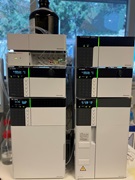Pigment analysis is an efficient tool in aquatic monitoring and process studies
Pigment analysis with High Pressure Liquid Chromatography (HPLC) is a rapid, very sensitive and objective method for determining the phytoplankton composition and for estimating the biomass of the different algal groups. Investigations in Danish waters have proven a high correlation between algal composition determined from pigments and from microscopical analysis (Schlüter & Havskum, 1997, Schlüter et al. 2000).

DHI holds a DANAK accreditation

The Danish Accreditation Fund has authorised DHI to carry out accredited measurements of pigment concentrations in the aquatic environment in accordance with ISO 17025. Validation follows the DHI Standard Operating Procedure (SOP) No. 30/852:05: “Accredited measurements of pigment concentrations in the aquatic environment”, and include injections of DHI mixed pigments to verify the calibration of the HPLC, correct elution, retention times, and documenting the precision and response factor stability. Furthermore, an internal standard is used for correcting, e.g., evaporation. The identification of the individual pigments in each sample is confirmed by controlling the relative retention times and the absorption spectra.
DHI has participated in five SeaHARRE intercomparisons (SeaWIFS HPLC Analysis Round-Robin Experiments, Hooker et al. 2005, 2009, 2010, 2012, and in prep.) and became in each of them a part of the QA subset (the QA subset is determined from performance metrics and the average results of the QA subset are used as the reference values (proxy for truth).
The HPLC method used at DHI for analysing pigments is based on the Van Heukelem & Thomas (2001) method, which in the SeaHARRE intercomparisons has shown to provide `state-of-the-art' results. The method provides separation of more than 30 of the most important phytoplankton pigments in freshwater, estuarine, and oceanic environments. DHI has many years of experience in pigment analyses by HPLC and record long-term information on precision and accuracy, LOD/LOQ, pigment resolution and retention time stability, calibration accuracy, etc.
Services
- We analyse your phytoplankton samples by HPLC and report the concentration of the pigments we identify and for which we have standards. Please down load our filtration procedure here
- We can help you setup your HPLC for pigment analyses in your laboratory. Please contact us at c14@dhigroup.com for more information.
Selected references:
Schlüter L., G. David, N.O.G. Jørgensen, R. Podduturi, A. Tucci, A.S. Dias, R. José da Silva (2018). Characterization of phytoplankton by pigment analysis and the detection of toxic cyanobacteria in reservoirs with aquaculture production.Aquacult.Environ.Interact. 10: 35–48.
Schlüter, L, S. Behl, M. Striebel, H. Stibor (2016). Comparing microscopic counts and pigment analyses in 46 phytoplankton communities from lakes of different trophic state. Freshwater Biology, 61: 1627-1639.
Schlüter, L., F. Møhlenberg, and H. Kaas (2014). Temporal and spatial variability of phytoplankton monitored by a combination of monitoring buoys, pigment analysis and fast screening microscopy in the Fehmarn Belt Estuary. Environ. Monit. Assess. DOI 10.1007/s10661-014-3767-9.
Schlüter, L., P. Henriksen, T.G. Nielsen, and H.H. Jakobsen (2011). Phytoplankton composition and biomass across the southern Indian Ocean. Deep-Sea Research I 58: 546-556.
Havskum, H., L. Schlüter, R. Scharek, E. Berdalet, and S. Jacquet (2004). Routine quantification of phytoplankton groups: microscopy or pigment analyses? Mar.Ecol.Prog.Ser. 273: 31-42.
Schlüter, L. F. Møhlenberg, H. Havskum and S. Larsen (2000). The use of phytoplankton pigments for identifying and quantifying phytoplankton groups in coastal areas; testing the influence of light and nutrients on pigment/chlorophyll a-ratios. Mar.Ecol.Prog.Ser. 192: 49-63.
Hooker, S.B., L. Van Heukelem, C.S. Thomas, H. Claustre, J. Ras, L. Schlüter, J. Perl, C. Trees, V. Stuart, E. Head, R. Barlow, H. Sessions, L. Clementson, J. Fishwick, C. Llewellyn, and J. Aiken, (2005). The Second SeaWiFS HPLC Analysis Round-Robin Experiment (SeaHARRE-2). NASA Tech. Memo. 2005-212785, NASA Goddard Space Flight Center, Greenbelt, Maryland, 112 pp.
Hooker, S.B., L. Van Heukelem, C.S. Thomas, H. Claustre, J. Ras, L. Schlüter L. Clementson, D. Linde, E. Eker-Develi, J-F. Berthon, R. Barlow, H. Sessions, H. Ismail, and J. Perl (2009). The Third SeaWiFS HPLC Analysis. Round-Robin Experiment (SeaHARRE-3). NASA Tech. Memo. 2009-215849, NASA Goddard Space Flight Center, Greenbelt, Maryland, 97 pp.
Hooker, S.B., C.S. Thomas, L. Van Heukelem, L. Schlüter, M.E. Russ, J. Ras, H. Claustre, L. Clementson, E. Canuti, J-F. Berthon, J. Perl, C. Nomandeau, J. Cullen, M. Kienast, and J.L. Pinckney, 2010: The Fourth SeaWiFS HPLC Analysis Round-Robin Experiment (SeaHARRE-4). NASA Tech. Memo. 2010-215857, NASA Goddard Space Flight Center, Greenbelt, Maryland, 74 pp.
Hooker, S.B., L. Clementson, C.S. Thomas, L. Schlüter, M. Allerup, J. Ras, H. Claustre, C. Nomandeau, J. Cullen, M. Kienast, W. Kozlowski, M. Vernet, S. Chakraborty, S. Lohrenz, M. Tuel, D. Redalje, P. Cartaxana, C.R. Mendes, V. Brotas, S.G.P. Matondkar, S.G. Parab, A. Neeley, and E.S. Egeland (2012). The Fifth SeaWiFS HPLC Analysis Round-Robin Experiment (SeaHARRE-5). NASA Tech. Memo. 2012-217503, NASA Goddard Space Flight Center, Greenbelt, Maryland, 95 pp.
Van Heukelem, L. & C. Thomas (2001). Computer assisted high-performance liquid chromatography method development with applications to the isolation and analysis of phytoplankton pigments. J.Chromatogr. A. 910: 31-49.